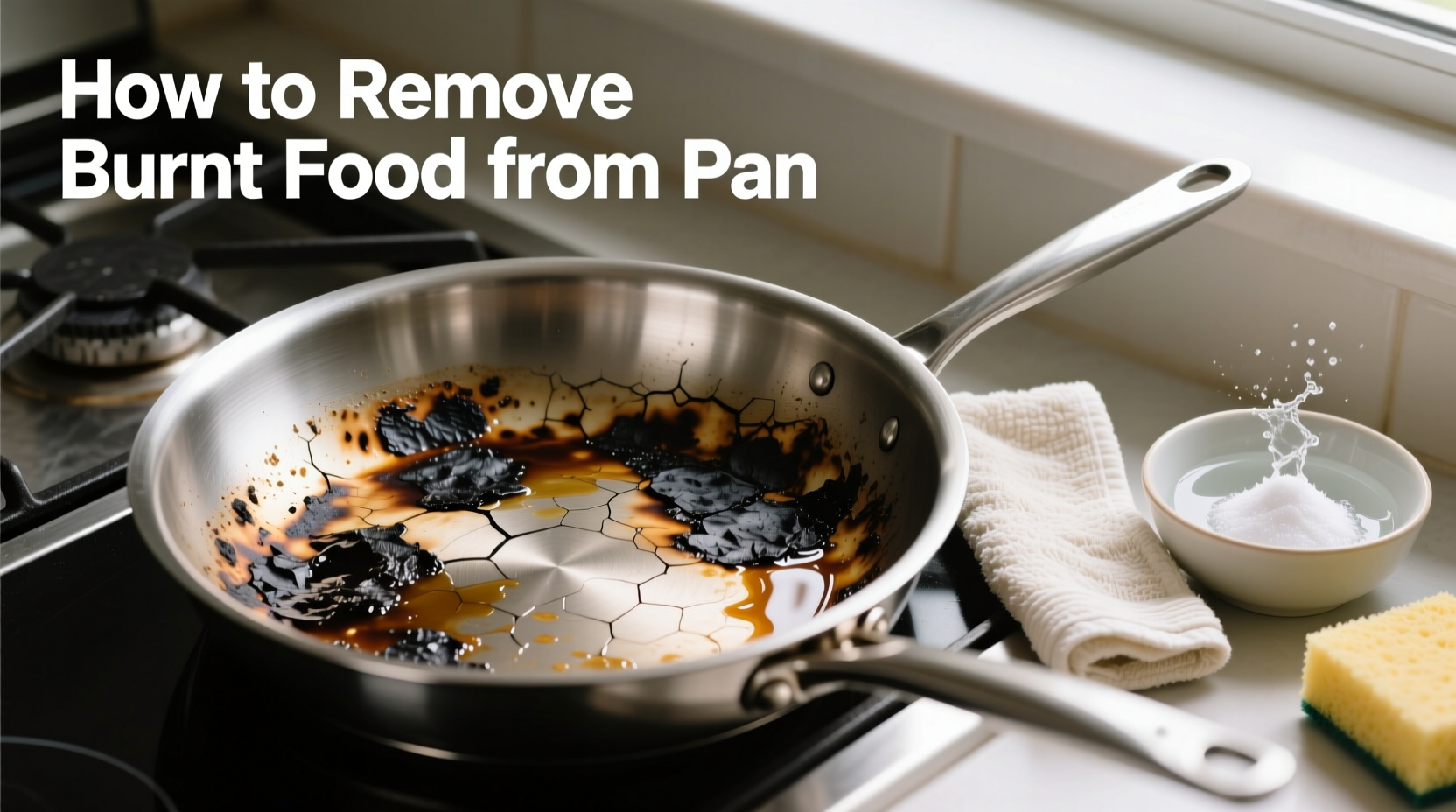Immediately soak your burnt pan in hot water with baking soda or vinegar for 15-30 minutes, then gently scrub with a non-abrasive pad. For stubborn residue, simmer a mixture of water and baking soda for 10-15 minutes before scrubbing. Never use steel wool on non-stick surfaces.
Stop Pan Panic: Your Complete Guide to Removing Burnt Food Safely
Nothing ruins kitchen confidence faster than burnt food cemented to your favorite pan. Whether you got distracted while searing steak or simmering sauce, that stubborn charred layer seems impossible to remove. But before you toss your cookware or resort to damaging scrubbing, know this: virtually all burnt-on food can be removed safely with the right technique. This guide delivers proven methods that work on stainless steel, cast iron, and non-stick surfaces without harming your cookware.
Why Burnt Food Sticks (And Why It's Not Hopeless)
When food burns, the Maillard reaction creates complex polymers that bond strongly with metal surfaces. This isn't just surface dirt—it's a chemical adhesion requiring specific approaches. According to the USDA National Agricultural Library, these carbonized compounds require both thermal and chemical intervention for safe removal. The good news? You don't need harsh chemicals or dangerous scrubbing.
Your Immediate Action Plan: First 5 Minutes After Burning
Timing matters most with burnt pans. Follow these critical first steps before the residue fully hardens:
- Don't panic-scrub - Forcing a cold scrubber creates microscopic scratches that trap future residue
- Add liquid immediately - Pour 1-2 cups of hot water into the warm (not hot) pan to begin loosening bonds
- Never add cold water to hot pan - Thermal shock can warp metal or crack ceramic surfaces
- Cover and wait - Let the pan sit with liquid for 15 minutes minimum before attempting removal

Method 1: The Baking Soda Boil (Most Effective for Stainless Steel)
This science-backed approach leverages alkaline chemistry to break carbon bonds:
- Add 1 cup water and ¼ cup baking soda to the pan
- Bring to gentle simmer for 10-15 minutes (do not boil vigorously)
- Remove from heat and let cool 5 minutes
- Use nylon scrubber in circular motions - residue should lift easily
- Rinse thoroughly and dry immediately to prevent water spots
Pro tip: For extra stubborn spots, make a baking soda paste (3 parts baking soda to 1 part water) and apply directly before simmering.
Method 2: Vinegar Soak (Best for Cast Iron and Carbon Steel)
Acidic vinegar dissolves mineral deposits that bind burnt food to metal surfaces. The University of Illinois Extension confirms vinegar's effectiveness for removing cooked-on food residues without damaging seasoning:
- Mix equal parts white vinegar and water to cover burnt area
- Simmer gently for 15 minutes (never boil vinegar)
- Cool completely before handling
- Use chainmail scrubber or stiff nylon brush in circular motions
- Wash with mild soap, dry thoroughly, and re-season with oil
| Cleaning Method | Best For | Time Required | Risk Level |
|---|---|---|---|
| Baking Soda Boil | Stainless steel, enameled cast iron | 20-30 minutes | Low |
| Vinegar Soak | Cast iron, carbon steel | 30-45 minutes | Medium (requires re-seasoning) |
| Dish Soap Soak | Non-stick, ceramic | 2-12 hours | Very Low |
| Bar Keepers Friend | Stainless steel only | 10-15 minutes | High (never on non-stick) |
Method 3: The Overnight Soak (Safest for Non-Stick Pans)
Non-stick surfaces require special care. The American Council of Consumer Interests warns against abrasive cleaners that damage the coating. Instead:
- Fill pan with hot water and 2 tablespoons dish soap
- Add ½ cup ammonia-free cleaner like OxiClean (optional)
- Cover and let sit overnight
- In morning, gently wipe with soft sponge
- For remaining spots, use melamine foam (magic eraser) with water only
What Never to Do With Burnt Pans
Avoid these common mistakes that can ruin your cookware permanently:
- Using steel wool on non-stick or ceramic surfaces
- Scraping with metal utensils
- Using oven cleaner (too harsh for cookware)
- Leaving vinegar solutions overnight on aluminum
- Putting extremely hot pans in cold water
Preventing Burnt Food: Pro Techniques That Work
Prevention beats correction every time. Professional chefs follow these practices:
- Temperature control: Use medium heat for most cooking - high heat causes rapid burning
- Proper preheating: Heat pan gradually before adding oil (test with water droplets)
- Oil selection: Use higher smoke point oils (avocado, canola) for high-heat cooking
- Regular stirring: Set timer for frequent stirring during simmering
- Pan maintenance: Season cast iron properly and replace non-stick when scratched
When to Replace vs. Repair Your Pan
Not all damage can be fixed. According to Cookware Manufacturers Association guidelines, replace your pan if:
- Non-stick coating is peeling or scratched deeply
- Stainless steel shows warped base or rivet holes
- Cast iron has cracks or significant pitting
- You've used oven cleaner on non-stick surfaces
Safety note: Never use a pan with compromised integrity as it can leach metals into food.











 浙公网安备
33010002000092号
浙公网安备
33010002000092号 浙B2-20120091-4
浙B2-20120091-4